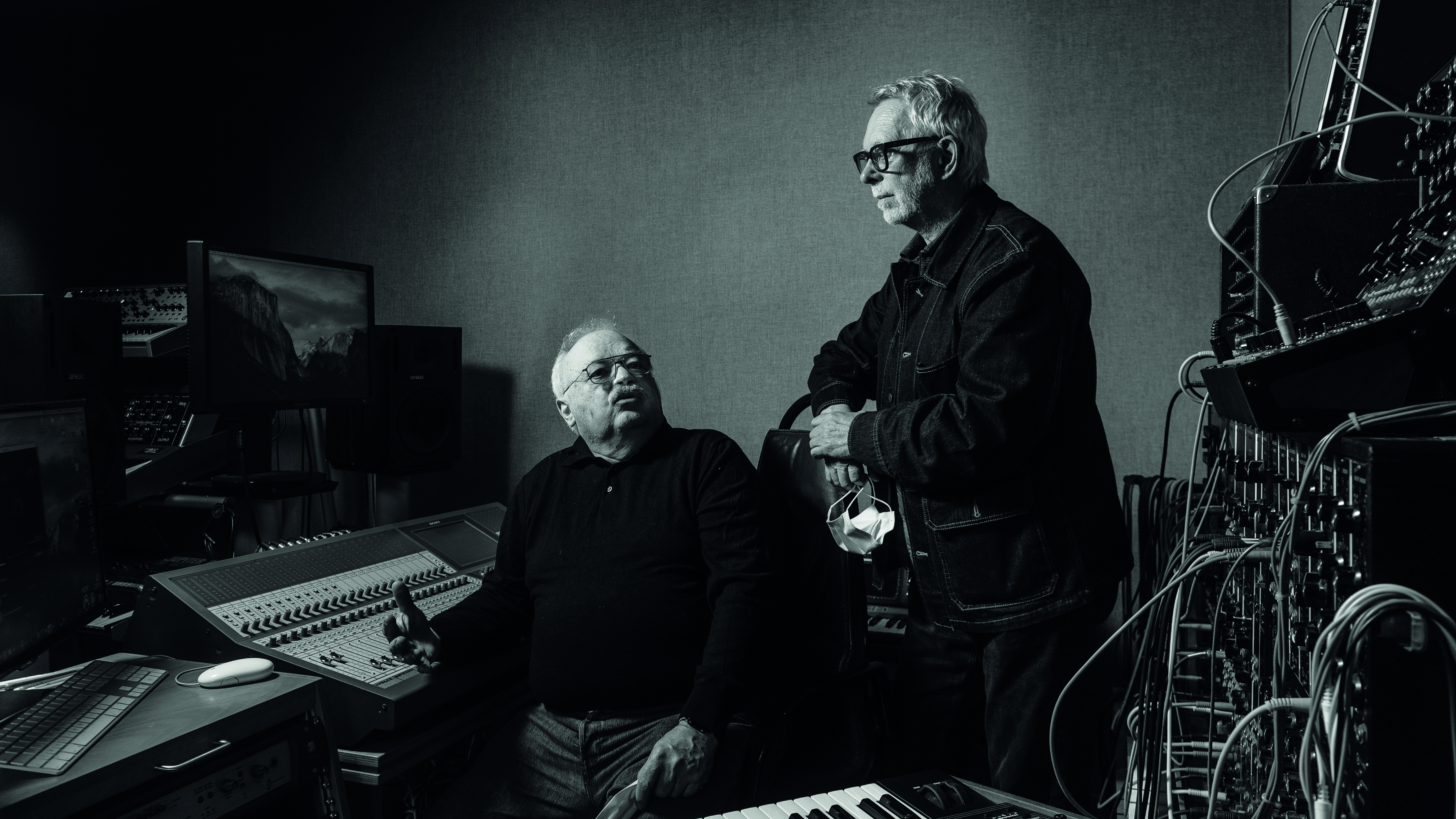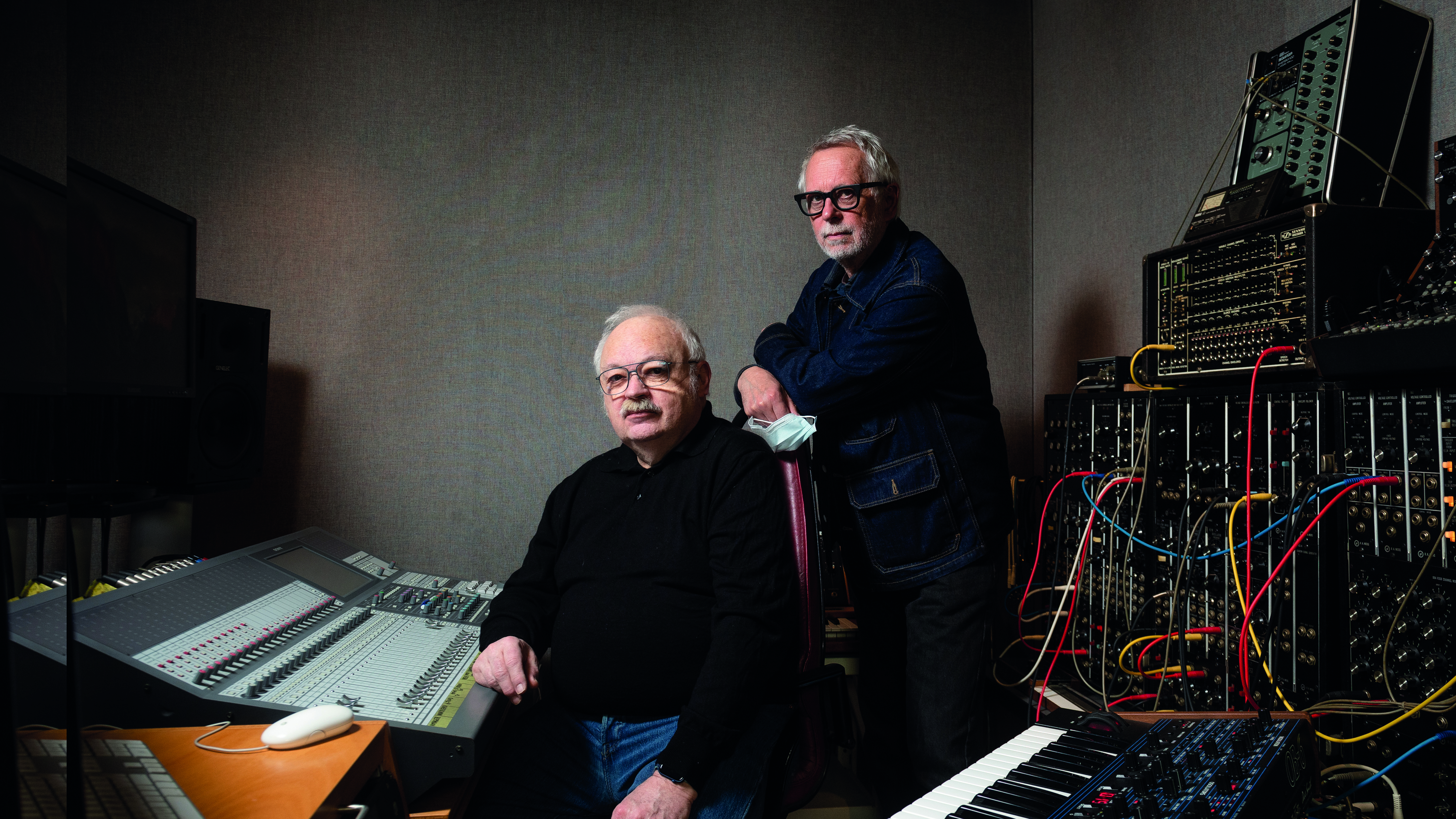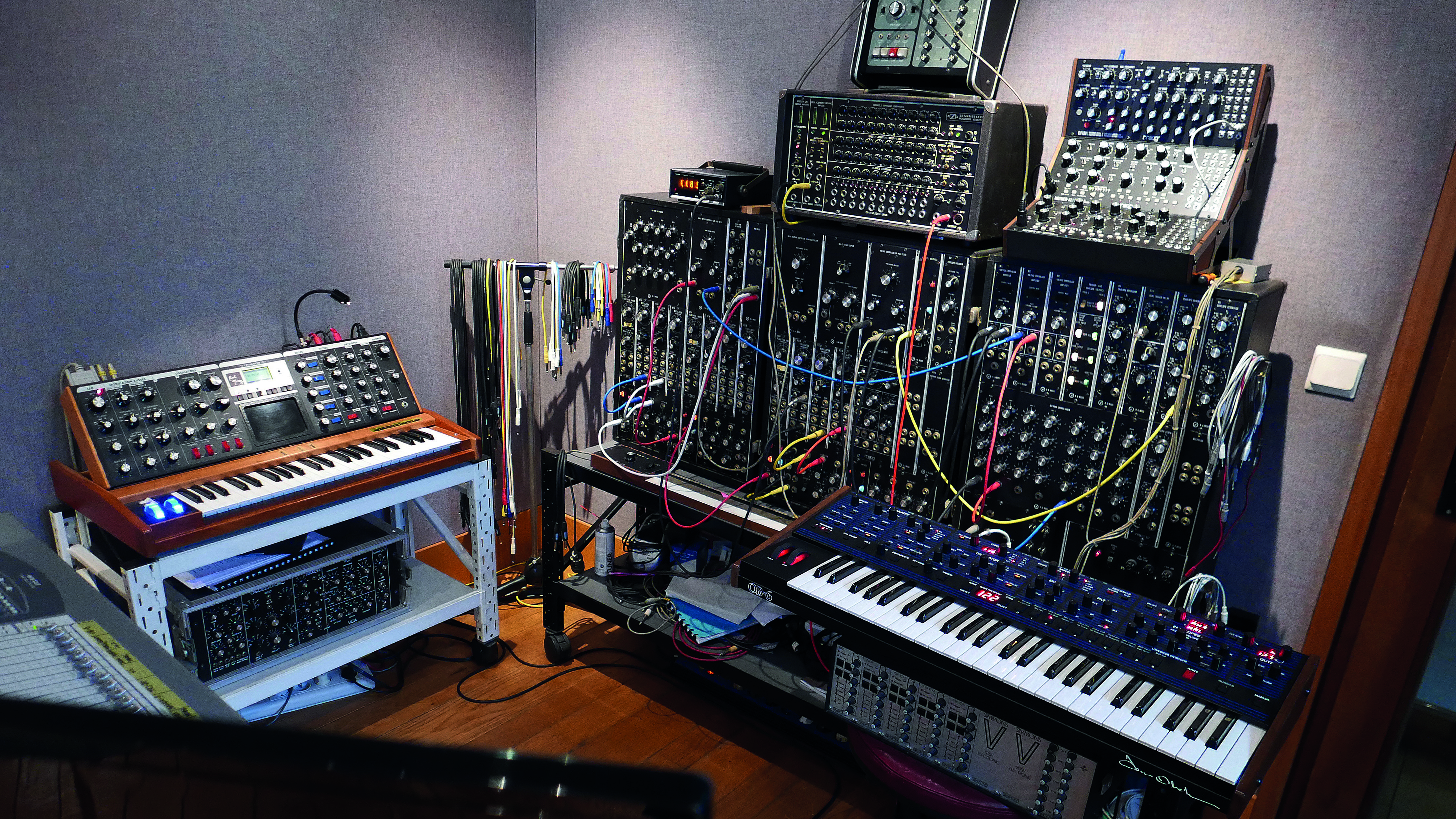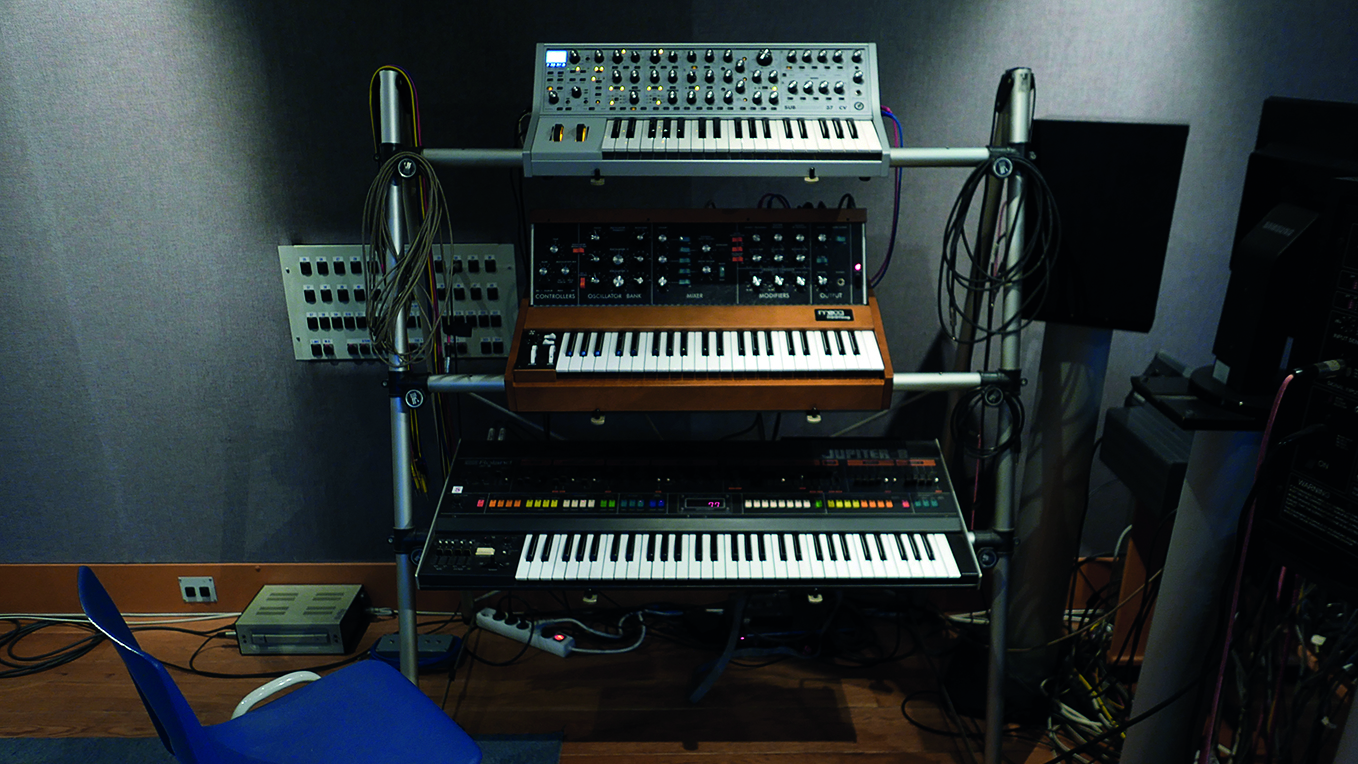Telex: "When we went on Top of the Pops I was sitting next to Gary Numan for an hour and he didn’t say a word"
Belgian trio Telex were one of the first to bring electronic pop to the European hit parade. We chat to Dan Lacksman and Michel Moers about the band’s past and present

Formed in 1978 by vocalist Michel Moers, keyboard enthusiast Marc Moulin and sound engineer Dan Lacksman, Brussels-based Telex blended experimental electronic music with disco and pop through their stripped-down cover versions and self-depreciative songwriting.
The group’s success peaked in 1980 when, despite their misgivings, they were persuaded to take part in the Eurovision Song Contest.
Preferring to remain anonymous and shunning live performance, they teamed up with glam-rock synth poppers Sparks, remixed Depeche Mode and the Pet Shop Boys and released albums intermittently up to 2006.
However, after the untimely death of Moulin two years later, Telex decided to call it a day. Thankfully, a final flurry of activity now sees them working with Mute Records to rework their back catalogue and release a 14-track compilation featuring unreleased tracks.

What were your musical backgrounds prior to forming Telex?
MM: “Marc was into jazz and fusion, I was into rock, folk and jazz and Dan more pop and electro music. He was the first one to play with synths and listen to that music, although Marc did have a Minimoog.
"We all had specific roles in the band. Marc was the keyboard player and composer, I was the singer and composer and Dan the sound wizard. We had opinions about each other’s actions, but the best thing was that there were three of us so there was always a majority for decisions we made.”
Get the MusicRadar Newsletter
Want all the hottest music and gear news, reviews, deals, features and more, direct to your inbox? Sign up here.
DL: “I was working as an assistant engineer and then a freelance engineer and was very interested in a new instrument called the synthesizer and managed to buy an EMS VCS3 just when Gershon Kingsley’s big hit Popcorn came out in 1969.
"Everybody was discovering the synthesizer and a lot of artists wanted to have some electronic sounds on their arrangements. After a few months I knew how to use it and thanks to my studio boss we did a masterclass demonstration and I began working as a synth programmer and specialist for Belgian productions, going from studio to studio.”
Kraftwerk’s ethos was futurism and the relationship between man and machine. Did you have a similar message for Telex?
MM: “The whole of the first album, Looking for Saint Tropez, was about communication - or lack of it - through the machines, but we never played the game of being robots. It was more about making pop music related to the cartoons that we were surrounded by in Belgium.
We all had specific roles in the band. Marc was the keyboard player and composer, I was the singer and composer and Dan the sound wizard.
Michel Moers
"When we began there was only Kraftwerk, so the influence was more related to the simplicity of their sound and the beginning of rhythmic electronic music. Other artists like Tangerine Dream and Klaus Schulze were more temperamental-sounding.”
DL: “Kraftwerk were my influence and closer to what we wanted to do because they did everything electronically whereas even Yellow Magic Orchestra used real drums. Before Telex, I experimented a lot with modular synthesizers to make drum sounds and one of the first things Florian Schneider told me years later was that he was astonished we could do that using modular equipment because Kraftwerk only had a rhythm box that they used to take apart.”
What modular gear were you using to make those drum rhythms?
DL: “Everything came from the Modular Moog. I found a way to sync a little eight-note click and trigger a module called the Envelope Follower that allowed you to generate a sound every four beeps. Every four was the bass drum, so I mixed oscillators, noise gates and different envelopes to get a bass drum sound and made a kind of snare and a hi-hat.”
As mentioned, you became friends with Florian Schneider. What would you talk about?
DL: “At the beginning I didn’t dare to talk about music, so we mostly spoke about Belgian beer and food because he wanted to get away from the technical side of his job. Of course he was telling me stories about Kraftwerk on tour and what happened sometimes, but not a lot.
"Once he asked if we could do a track together about plastic pollution and I was pinching myself. At the time, his studio was not ready but he knew mine well because we used to meet here every time he came to Brussels. Florian liked Brussels very much and thought about buying a house here because he liked the atmosphere.”
One of your most well-known tracks was Moskow Diskow. Was it influenced by Kraftwerk’s Trans Europe Express?
DL: “Not really - they’re both about trains, but we had this crazy idea of having a disco in a train and wanted to build the sound of a train into the rhythm track and make the steam engine sound like a hi-hat rhythm. It’s a strange idea because if you listen to a real train the tempo’s not constant because when the train goes faster so does the steam [laughs].”
Did you all share a vision that electronic pop would be the music of the future and want to be a part of that process?
MM: “We didn’t really think about the future, we just wanted to do something of our own with all these new instruments – something far away from rock ‘n’ roll and the other music coming from America. We were trying to make continental music with machines, but thought our music would be disposable after six months as fashions change a lot.”

Some of the early electronic artists were quite envious that Gary Numan was the first to popularise electronic music, were you?
MM: “We weren’t surprised because Are ‘Friends’ Electric? was impressive and what he was doing was very powerful. The only thing I remember is that when we went to the BBC to be on Top of the Pops I was sitting next to Gary Numan for an hour and he didn’t say a word because he wasn’t very talkative.”
DL: “The electronic sound he made was part of the song and the arrangement, but it was mainly about writing good songs. The first OMD records and Soft Cell also wrote good songs.”
Tell us more about your debut album Looking for Saint Tropez and some of the early technologies you used on that record?
DL: “When I made my first album as Electronic System, by chance I made a little hit record using the EMS VCS3 so I could immediately invest in the big Moog modular system in 1972/73.
"When Telex started in 1977, we mainly used the Modular Moog, the Polymoog, the Sennheiser VSM 201 Vocoder and some sort of handmade sequencer that was strange because it didn’t even have a start button – it started immediately when you switched it on.”
Synths were obviously very expensive back then. Did you have to rent them?
DL: “No, I bought them because I was lucky enough to have a little hit called Coconut, so instead of giving my money to the tax man I bought the modular and used it professionally for my studio sessions.
"Thanks to my wife, I kept on investing in synthesizers and had a car full of equipment, and soon after our first album I bought an Oberheim OB-Xa that we also used a lot. This was all pre-MIDI, which is why Marc was so incredibly important to us. He was a very natural and sophisticated keyboard player who helped us to make music using the few tracks that were available to him.”
There’s a track on your first album called Ave Fifi, with what sounds like bird samples…
DL: “It is a real bird. My first studio was on the first floor above a shop and I had a canary called Fifi that was always following the tunes on the radio, so we said to ourselves 'why don’t we make a backing track for Fifi and record him?' We prepared a backing track, put a little speaker in front of the mic and when it was ready we took Fifi from the ground floor to the studio and he sang it in one take. The chords were based on Ave Maria, hence the title Ave Fifi.
"Sadly, I moved to a new location and brought a cat with me to kill some mice and one day we found Fifi completely terrified in his cage with the cat trying to catch him. He died a few hours later of a heart attack, so only then could we say ‘ave’ to Fifi.”
MM: “Fifi was probably the only natural sound on the album, although we cheated sometimes. On Moskow Diskow we used some real hand claps, a little shaker and vocals of course. We used a Fairlight in 1984, but the first real sample we used was a guitar chord on a track called Raised by Snakes.
"There was no sampler at the time, so we put the chord on an analogue tape machine and pressed the return button so we could inject the chord into the track. It was sampling done with a tape recorder, as the Beatles had done a long time before.”

Were you aware that there was a negative reaction to electronic instruments from those who feared they’d put musicians out of work?
DL: “At one of the first sessions I did at Studio Madeleine in Brussels there were a lot of string players in the studio. I was preparing my EMS VCS3 to record some electronic sounds and one of the musicians passed behind me, pointed at the VCS3 with a mean finger and said very loudly so that everyone could hear, ‘This is a machine we have to forget because it’s going to replace us all!’
“In London, the Musician’s Union was very against the first synthesizer, and that was a bit of a problem. What didn’t help is that when the Polymoog came out the company put names on its sounds like ‘strings’ and ’brass’, which was a pity because the synthesizer was much more than that. But the biggest problem was the Mellotron because it was a sampler that recorded real instruments.”
Telex was a bit like Daft Punk in that you didn’t want to show your faces or play live. Do you think that had a negative effect on your career?
MM: “It didn’t damage us but I understand what you mean because we were never stars. We were probably a bit older than most musicians that started and we wanted to have a normal life. The three of us did other things, Dan was in the studio working for people, Marc had a job in radio and I was an architect, so we didn’t want to quit everything and go on the road.
"Marc and I had been on stage before and there were always technical problems. With all those electronic instruments the problems would have been enormous.”

Moog Modular IIIP
“Our main synth for drum sounds, bass sounds and sequences. We used to pass sounds through its filters, too.”
Polymoog
“The first polyphonic synth we used, mainly for pads but also to create the vocoded choirs and polyphonic sequences through the Moog filter.”
Roland Sequencer System-100 Model 104
“Compatible with the Moog Modular but at a fraction of the Moog 960 sequencer price.”
Oberheim OB-X
“I wanted a companion polyphonic synth for the Polymoog that was programmable and could save and recall sounds. The Prophet-5 was difficult to obtain in Belgium and the OBX-8 had 8-voice polyphony and the Prophet only 5.”
“Time for sampling! In 1983, after working with Thomas Dolby on his second album, The Flat Earth, I decided to buy a Fairlight CMI. We used it a lot on Wonderful World and Looney Tunes.”
Sennheiser VSM201 Vocoder
“For choirs and ‘robotic’ vocals (like Rock Around The Clock). It has high intelligibility due to its design in quarter octave channels in the mid-range. Just as expensive as the Moog IIP.”
MXR Flanger
“We used it a lot on lead vocals, keyboards and the steam engine sound for Moskow Diskow.”
But you did take part in the Eurovision Song Contest in 1980. How’d that go?
MM: “When it was proposed we said you’re crazy, it’s not our environment, but after two weeks we decided pop music was the epitome of what we wanted to do.
"Everything was pre-recorded except for vocals and none of our gear was plugged in on stage because they were afraid of short circuits and fire, so all the machines were there just for show.”
DL: “The rules said you must bring a backing track but all the instruments on tape must be seen on stage. The drums were made with the modular, so we brought that on stage with a Polymoog and another keyboard but we had problems in rehearsal because the conductor said ‘Stop! I hear drums but don’t see any drums’, so I had to explain that the drums were made with a modular machine.”
MM: “We may not have done any concerts, but Eurovision had about 100 million people watching. I was nervous because I couldn’t hear myself on the speakers, although because of the lights I couldn’t see the audience anyway.
"We lost a lot of fans as they were wondering what on earth we were doing there… and didn’t get many new ones [laughs]. ”
On your third album, Sex, you enlisted Sparks to help write lyrics for you. How was your experience working with the duo?
MM: “It was great, especially thanks to Ron Mael’s sense of humour. I was enveloped in my own little room doing the vocals, but for Dan and Marc it was like being on a talk show.”
DL: “At first we were very impressed to be in the studio with Sparks, but one day in the middle of a session at my home studio Ron was sitting at the keyboard and we heard an ice cream van go by. Ron stood up, walked to the window and said ‘they’re calling me, they’re calling me’. We thought to ourselves, what’s he doing?
Bob Moog was a very nice guy but he didn’t like the design of the Polymoog. It wasn’t really one of his inventions.
Dan Lacksman
"It was a relief when he explained that when he was young he worked as an ice cream guy but was afraid to visit certain no-go places in Los Angeles where the little kids were always trying to steal his money. That’s why he developed that mean face and a little moustache. We thought that story was funny and from then on it was very relaxed in the studio.”
We don’t seem to have characters like Sparks today, and Telex had a sense of humour too…
MM: “It’s difficult to put humour in music because the line is very thin. With music, it’s easier to make people cry than laugh.”
DL: “The records that sell the most are hip-hop, and some of them are very good but the lyrics are very serious. There must be artists around with a sense of humour, but you don’t hear them very frequently due to the evolution of music genres.”
What explains the 18-year gap from 1988 to your final studio album How Do You Dance?
MM: “After Looney Tunes we’d get together from time to time to see what we could do, but every time we made a track we didn’t think it would be interesting enough to take it any further. We never split up and when Virgin London was bought by EMI they asked us to make the record How Do You Dance? At that time we had sufficient inspiration and were starting to have fun in the studio again, so we went ahead and made the album.”
Did you embrace digital technology when it arrived in the mid-’80s?
DL: “Everything was slowly evolving. I kept buying new machines like the Synclavier, which was the first digital synth, and then you had the FM synths.
"On the recording side, we kept using the multi-track machines and before Pro Tools we had the Fairlight III, which was the first direct-to-disk recorder. We used the technology of the time and you could do things you couldn’t do before, but you could always use analogue synths rather than plugins.
"When do you decide that something is obsolete? People continue to use very old machines working with valves rather than transistors and I think that’s what’s happened with analogue synths - they’ve created new machines because everything is possible depending on what you prefer the sound of.”
Why do you think so many producers have returned to modular synthesis?
DL: “If you use a computer – even if it has very good plugins, it reproduces the sound exactly the same every time and our brain recognises that you’ve heard that sound before. In some ways, it sounds sterile, but when you use an analogue machine there’s always some imperfection that makes the sound alive. That’s more interesting than the best sampler or whatever, but they both have good aspects to them so it’s just a question of using the best instrument for what you want to do.
"When I mix hip-hop tracks, they use a lot of samples, so I sometimes propose to make an analogue bass sound with a Minimoog because it puts life into the track.”
You seem more interested in hardware emulations of classic synths like the Moog Grandmother and Studio Electronics Midimoog now. How do they compare to vintage synths?
DL: “I don’t know why but I was always attracted to Moog - I tried ARP once but thought it sounded a bit thin by comparison. The problem is that every time there’s a new model I ask if I can try it, and every time I try it I end up keeping it. They are all so different and have that special character.
"The Midimoog is a real Minimoog put in a box with a great MIDI interface. The design of the original instrument had a mistake between the mixer and the filter where there’s a bit too much level that gives it a slight distortion and a very specific sound. They’ve tried to replicate that in some of the new synths like the Moog Subsequent 37, which doesn’t sound clean because it’s a bit overdriven.”
Did you ever get to meet any of the synth designers like Bob Moog, Tom Oberheim or Dave Smith?
DL: “I met Bob Moog at a trade show in Frankfurt just before I bought one of the first Polymoogs. In fact, I did a demonstration there because the guy who was demoing it was ill one day.
"The company was called Norlin and Bob was working for them. He was a very nice guy but he didn’t like the design of the Polymoog. It wasn’t really one of his inventions, but it was the first polyphonic synthesizer so it was a great new instrument. I would have really liked to have met Dave Smith because the OB-6 that he made with Tom Oberheim is a really fantastic polyphonic synth. I use it all the time because the sound is so incredibly rich.”
You have some modern technologies too, like the Arturia SparkLE drum machine…
DL: “Arturia does a pretty good job with all of its plugins, but the SparkLE is one of the first hybrid drum machines.”
When did you decide to work with Mute to release your new compilation This Is Telex?
MM: “It was the right time because we’d just escaped from a former contract that was dead for almost 15 years. Somebody suggested Mute Records, so I sent an email and was surprised because I thought we’d knock on the door and have to wait for a month but Daniel Miller answered the next day. It all went very fast and we soon started to think about remixing and remastering a lot of our tracks.”
DL: “Mute came to the studio and they were so enthusiastic, which was great for Michel and I. The first idea was to reissue everything but mainly start from the original master tapes and redo the transfers digitally because the quality of the converters is much better now. Then we sat between ourselves and thought about mixing some tracks from the album Sex again because we were not very satisfied with it. We started with one track and it went so well that we decided to listen back to everything and mix about 60 tracks. The idea was not to make them ‘better’; we just wanted to keep the spirit of the original tracks all the way through.”
Tell us about the undiscovered track The Beat Goes On/Off?
MM: “As I mentioned, we gathered in the ’90s from time to time and that was one attempt we made that we didn’t think was good enough. Having heard it again, we changed our mind and I knew I had it on a minidisk somewhere but couldn’t find it.
DL: “When we discovered the song we only had a rough mix, so once we found the multi-track we decided to do it again. We also mixed our cover version of the Siouxsie and the Banshees track Dear Prudence and put that on the compilation.”
Will we hear brand new Telex music one day?
MM: “I don’t think so; Marc played such an important part and isn’t a musician we can replace.
DL: Without Marc, it wouldn’t be Telex.”
The new Telex compilation album This Is Telex is out now on Mute Records.


Future Music is the number one magazine for today's producers. Packed with technique and technology we'll help you make great new music. All-access artist interviews, in-depth gear reviews, essential production tutorials and much more. Every marvellous monthly edition features reliable reviews of the latest and greatest hardware and software technology and techniques, unparalleled advice, in-depth interviews, sensational free samples and so much more to improve the experience and outcome of your music-making.
“Excels at unique modulated timbres, atonal drones and microtonal sequences that reinvent themselves each time you dare to touch the synth”: Soma Laboratories Lyra-4 review
e-instruments’ Slower is the laidback software instrument that could put your music on the fast track to success










